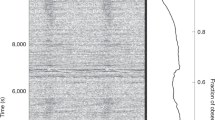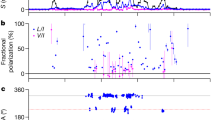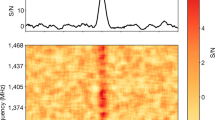Abstract
Geminga was discovered as a strong γ-ray source in the constellation Gemini over two decades ago1,2, and was later detected at X-ray3 and optical4 wavelengths. X-ray pulsations5 with a period of 237 ms established that it is a rotating neutron star. Although γ-ray pulses were subsequently discovered (once the period was known) in archived data6, no evidence for radio emission (either continuum or pulsed) was found; in this respect, Geminga is different from every other neutron star with pulsed emission. Here we report the detection of pulsed 102.5-MHz radio emission from Geminga, with a period of 237 ms. The flux density varies within the range 5–500 mJy and the pulse width varies between 10 and 80 ms. The small dispersion measure (2.9 ± 0.5 pc cm−3) confirms Geminga's proximity to the Sun and establishes it as the weakest known radio pulsar. This observation poses a considerable challenge for pulsar emission models, which must now be able to explain the exceptional contrast between the strength of the γ-ray and radio emission from this object.
This is a preview of subscription content, access via your institution
Access options
Subscribe to this journal
Receive 51 print issues and online access
$199.00 per year
only $3.90 per issue
Buy this article
- Purchase on Springer Link
- Instant access to full article PDF
Prices may be subject to local taxes which are calculated during checkout



Similar content being viewed by others
References
Kniffen, D. A. et al. Distribution of cosmic gamma rays in the galactic anticenter region as observed by SAS-2.in Proc. 14th Int. Cosmic Ray Conf. Vol. 1, 100–105 (Max-Planck-Institut für Extraterrestrische Physik, Munich, 1975).
Fichtel, C. E. et al. High-energy gamma-ray results from the second small astronomy satellite. Astrophys. J. 198, 163–182 (1975).
Bignami, G. F., Caraveo, P. A. & Lamb, R. C. An identification for ‘Geminga’ (2CG195+04) 1E0630+178)—A unique object in the error box of the high-energy gamma-ray source. Astrophys. J. 272, L9–L13 (1983).
Bignami, G. F. et al. Adeep optical study of the field of IE0630+178. Astrophys. J. 319, 358–361 (1987).
Halpern, J. P. & Holt, S. S. Discovery of soft X-ray pulsations from the gamma-ray source Geminga. Nature 357, 222–224 (1992).
Bertsch, D. L. et al. Pulsed high-energy gamma-radiation from Geminga (1E0630+178). Nature 357, 306–307 (1992).
Bignami, G. F., Gavazzi, G. & Harten, R. H. Synthesis observations of the region near the proposed new Milky Way companion at 0.610 GHz. Astron. Astrophys. 54, 951–954 (1977).
Mandolesi, N., Morigi, G. & Sironi, G. No evidence of pulsed radio emission at 325 MHz from CG195+04. Astron. Astrophys. 67, L5–L6 (1978).
Sieber, W. & Schlickeiser, R. Radio measurements in the fields of gamma-ray sources. I-CG195+04. Astron. Astrophys. 113, 314–323 (1982).
Caraveo, P. A. et al. An identification for Geminga—A review of all the available data. Adv. Space Res. 3, 77–81 (1984).
Spoelstra, T. A. Th. & Hermsen, W. Ratio observations at 21 cm wavelength in the direction of Geminga. Astron. Astrophys. 135, 135–140 (1984).
özel, M. E., Dickel, R. J. & Webber, J. S. Upper limit to any 59.35-s periodic radio emission at 18 cm for mCG195.5+4.5. Nature 285, 645–647 (1980).
Seiradakis, J. H. A928 MHz search for periodicities in 2CG195+O4. Astron. Astrophys. 101, 158 (1981).
Manchester, R. N., D'Amico, N. & Tuchy, I. R. Asearch for short-period pulsars. Mon. Not. R. Astron. Soc. 212, 975–986 (1985).
Seiradakis, J. H. IAU Circ. No. 5532 (1992).
Kuzmin, A. D. & Losovsky, B. Ya. IAU Circ. No. 6559 (1997).
Shitov, Yu. P. & Pugachev, V. D. Radio pulsar Geminga. Preprint No. 33, Lebedev Physical Inst. (1997).
Shabanova, T. Evidence for planet around the pulsar PSR B0329+54. Astrophys. J. 453, 779–782 (1995).
Taylor, J. H. & Cordes, J. M. Pulsar distances and the galactic distribution of free electrons. Astrophys. J. 411, 674–680 (1993).
Caraveo, P. A. et al. Parallax observations with the Hubble Space Telescope yield the distance to Geminga. Astrophys. J. 461, L91–L94 (1996).
Izvekova, V. A., Malofeev, V. M. & Shitov, Yu. P. The shapes of mean pulse profiles of pulsars radio emission at the frequency 102.5 MHz. Astron. Zh. 66, 345–354 (1989).
Bignami, G. F. & Caraveo, P. A. Geminga: it's phenomenology, it's fraternity, and it's physics. Annu. Rev. Astron. Astrophys. 34, 331–381 (1996).
Malofeev, V. M. Pulsar radio spectra.in Pulsars: Problems and Progress (eds Johnston, S., Walker, M. A. & Bailes, M.) 271–277 (ASP Conf. Ser. Vol. 105, Astron. Soc. Pacific, San Francisco, 1996).
Acknowledgements
We thank K. Lapaev, S. Tyul'bashev, N. Shchegoleva and T. Shabanova for their help with the observations and the reduction program; W. Sieber, D. Lorimer and I. Malov for discussions and careful reading of the manuscript; and V. Shishov, R. Wielebinski and M. Kramer for discussions and support. This work was supported by INTAS and the Russian RFFI.
Author information
Authors and Affiliations
Corresponding author
Rights and permissions
About this article
Cite this article
Malofeev, V., Malov, O. Detection of Geminga as a radio pulsar. Nature 389, 697–699 (1997). https://doi.org/10.1038/39530
Received:
Accepted:
Issue Date:
DOI: https://doi.org/10.1038/39530
This article is cited by
-
Radio emission from AXP and XDINS
Astrophysics and Space Science (2007)
Comments
By submitting a comment you agree to abide by our Terms and Community Guidelines. If you find something abusive or that does not comply with our terms or guidelines please flag it as inappropriate.



